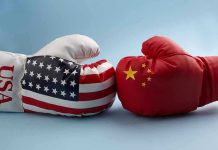
Port of Los Angeles braces for a staggering 35% drop in shipments as Trump’s strong tariff policies force major retailers to halt imports from China, potentially leaving American consumers with fewer choices and higher prices.
Key Takeaways
- Shipments at the Port of Los Angeles are projected to plummet by 35% in the coming weeks as retailers cease imports from China due to tariff disputes.
- The current tariff structure includes a 145% rate on Chinese goods and a 10% rate on products from nearly all other nations, significantly impacting U.S. consumer markets.
- Many retailers only have a 5-7 week inventory buffer before supply shortages will become apparent to consumers.
- Transport companies are attempting to pivot to Southeast Asian sources, but these alternative supply chains are already showing strain.
- Industry experts warn of potential layoffs in transportation and retail sectors if the tariff situation remains unresolved.
Port Traffic Set to Plunge as Tariffs Take Effect
The Port of Los Angeles, America’s busiest container port, is forecasting a dramatic 35% drop in cargo volume in the coming weeks as the effects of the administration’s tariff policies begin to materialize. Port Executive Director Gene Seroka has been monitoring the situation closely, noting that the slowdown is already being felt throughout the supply chain. Data from Wabtec Corp. shows a significant decrease in Twenty-foot Equivalent Units (TEUs), the standard measurement for shipping containers, compared to the same period last year. With China accounting for approximately 45% of the port’s operations, the impact of the current trade tensions cannot be overstated.
“It’s my prediction that in two weeks’ time, arrivals will drop by 35% as essentially all shipments out of China for major retailers and manufacturers have ceased, and cargo coming out of Southeast Asia locations is much softer than normal,” said Seroka.
The administration’s tariff structure includes a 145% rate on Chinese goods and a 10% rate on nearly all nations. Despite a 90-day pause on reciprocal tariffs announced recently, industry experts suggest this provides insufficient time for businesses to adapt their supply chains. As Seroka noted, “that’s not a lot of lead time for the industry to make decisions on procurement, manufacturing, locations or sourcing.” This rapid implementation timeline has left many businesses scrambling to develop alternative strategies.
Shipments from China to drop by 35% next week due to Trump tariffs, Port of LA chief warns https://t.co/UcNXbZBW1D pic.twitter.com/DGXokf17vb
— New York Post (@nypost) April 29, 2025
Retailers Face Inventory Challenges and Strategic Decisions
Major American retailers have taken the dramatic step of halting shipments from China entirely, creating a ripple effect throughout the supply chain. According to port authorities, most retailers currently have between five to seven weeks of inventory in their systems – a buffer created through pre-tariff stockpiling. However, this supply cushion will quickly be depleted if new sources aren’t secured. Industry analysts predict that consumers will soon notice both reduced product variety on store shelves and increased prices as retailers absorb or pass along tariff costs.
The impact extends beyond retail to agriculture, manufacturing, and IT sectors as retaliatory tariffs take effect. Some companies are attempting to diversify by seeking new suppliers in Southeast Asia, but these efforts face challenges as established supply chains cannot be easily replicated. Transit times, quality control systems, and manufacturing capacity all present obstacles to a smooth transition away from Chinese suppliers. Meanwhile, with the U.S. and China both implementing tariffs exceeding 100% on many goods and no substantial negotiations on the horizon, businesses are preparing for a prolonged period of disruption.
Economic Impact on American Workers and Consumers
The maritime industry contributed nearly $300 billion in economic output and supported approximately 2 million jobs in 2022, making the current slowdown particularly concerning for American workers. The immediate effects are being felt by truckers and dock workers, especially casual workers who rely on consistent cargo volume. If the situation persists, experts warn that layoffs could extend throughout the transportation and retail sectors, potentially contributing to broader economic challenges.
“It’s a precipitous drop in volume with a number of major American retailers stopping all shipments from China based on the tariffs,” explained Seroka, adding that “the pain is being felt on both sides of the Pacific.”
For consumers, the potential impacts of these trade policies will become increasingly visible in the coming months. While supporters of the tariffs argue they are necessary to level the playing field with China and protect American manufacturing, critics point to the immediate cost increases and supply disruptions. How quickly American businesses can adapt their supply chains, and whether these tariffs achieve their intended policy goals, remains to be seen. In the meantime, the Port of Los Angeles serves as a clear barometer of the economic challenges ahead.















